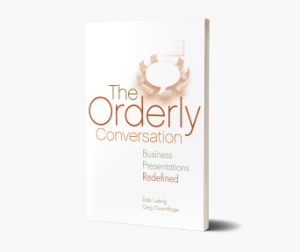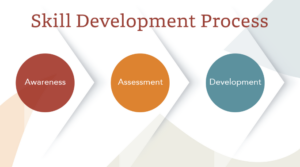
- Dale Ludwig Meetings, Presentations
Active listening is one of the many communication skills we help our clients develop in our communication skills workshops. Like so many communication skills, we need to be intentional in their use until they develop into a habit.
Recently, I read an article in the Harvard Business Review titled “What Is Active Listening” by Amy Gallo. She has some solid, practical insight into how to listen better.
If we back up and look at the communication skill development process in general, we can see that it involves three steps. They are:
- Awareness of the skills required in a given situation
- Assessment of how well an individual uses these skills
- Development of the skills and behaviors needed to improve
By staying focused on these three steps, we’re able to zero in on what is required in a given communication situation, avoid generic recommendations, and focus on personalized, appropriate adjustments for our clients.
The HBR article does a really nice job of creating awareness of what active listening is (the first step) and then takes it a step further by offering a way to assess your default listening style (the second step). In this article, I’ll cover a few ideas about what you can do to take the third step to develop your listening skills.
Awareness: What does active listening require?
According to Gallo, active listening occurs when you “not only hear what someone is saying, but also attune to their thoughts and feelings.” Not only is it necessary to take in what is said by someone else, but we also need to pay attention to why it is being said and how the speaker feels about what they’re saying. Adding to this challenge, listeners need to keep their own emotions in check and do their best to be patient and open.
Given all of this, it’s no surprise that good listening is so rare.
Assessment: How do you listen?
The next step is to assess your listening skills. What are your habits and preferences? A listening breakdown goes beyond the usual distractions that we experience every day—texts coming in during a conversation or the stress of a previous meeting affecting your ability to focus during this meeting. All of these things affect our ability to focus and listen well.
But Gallo takes things to another level. Citing the work of Rebecca Minehart, Benjamin Symon, and Laura Rock, she identifies four different listening styles, each of them affecting one’s ability to listen fully. Here they are:
- A task-oriented listener is focused on efficiency and shapes the conversation around the transfer of important information.
- An analytical listener aims to analyze a problem from a neutral starting point.
- A relational listener seeks to build connections and understand and respond to the emotions underlying a message.
- A critical listener typically judges both the content of the conversation and the speaker.
Development: What can you do to adapt to your listening default?
Each of these listening defaults has a place in business communication, but being aware of your preferences is a good first step toward understanding how to adapt and when. For example,
- Task-oriented listeners may be frustrated by a conversation that wanders or turns back on itself. So, patience is required. Pause, listen, and see if you can get a sense of what’s causing the meandering conversation. Is it confusion? An underlying issue just below the surface?
- Analytical listeners may ignore the emotions someone else is experiencing, focusing instead on analysis and objectivity. When your direct report wants to vent, and you’re focused on analysis, you should shift your listening to a more relational approach. Let them vent because when they’re finished, they will be more open to analysis.
- Relational listeners might be frustrated by someone who hates small talk or withholds personal information. Learning not to take these things personally is an important first step. Staying focused on what that person chooses to talk about may help you build trust.
- Critical listeners may be good managers or coaches, but they could also struggle to listen objectively. Taking a step back to listen to what is being said without judgment or prejudice might open the door to a better interaction. Understand that there are times when simple understanding is all the conversation requires from you.
Development: What speakers can do to help others listen.
For speakers, it’s our job to make listening easy for others. Understanding the listening defaults of the people you’re talking to is useful because it helps you understand that people value different aspects of the conversation. And that’s okay. This helps you be more patient and more open to people different than you. It helps you answer questions like these: How are people responding to what I’m saying? Am I speaking in a way that is appropriate for this group or individual? Am I able to adapt to the needs of others?
The way you adapt will vary depending on your listeners’ listening defaults. For example, for
- Task-oriented listeners, be more direct.
- Analytical listeners, focus on logic and context.
- Relational listeners, be open to the value of building interpersonal relationships.
- Critical listeners, be more aware that they are assessing both you and what you’re saying, perhaps focusing more on engagement, flexibility, and clarity.
Many years ago, a colleague told me she thought it was impossible to teach people how to listen better. She was referring to college students listening in class, so on some level, she may have been right. But by understanding our responsibilities as listeners and our listening habits and preferences, we can all take the first step toward listening better.



